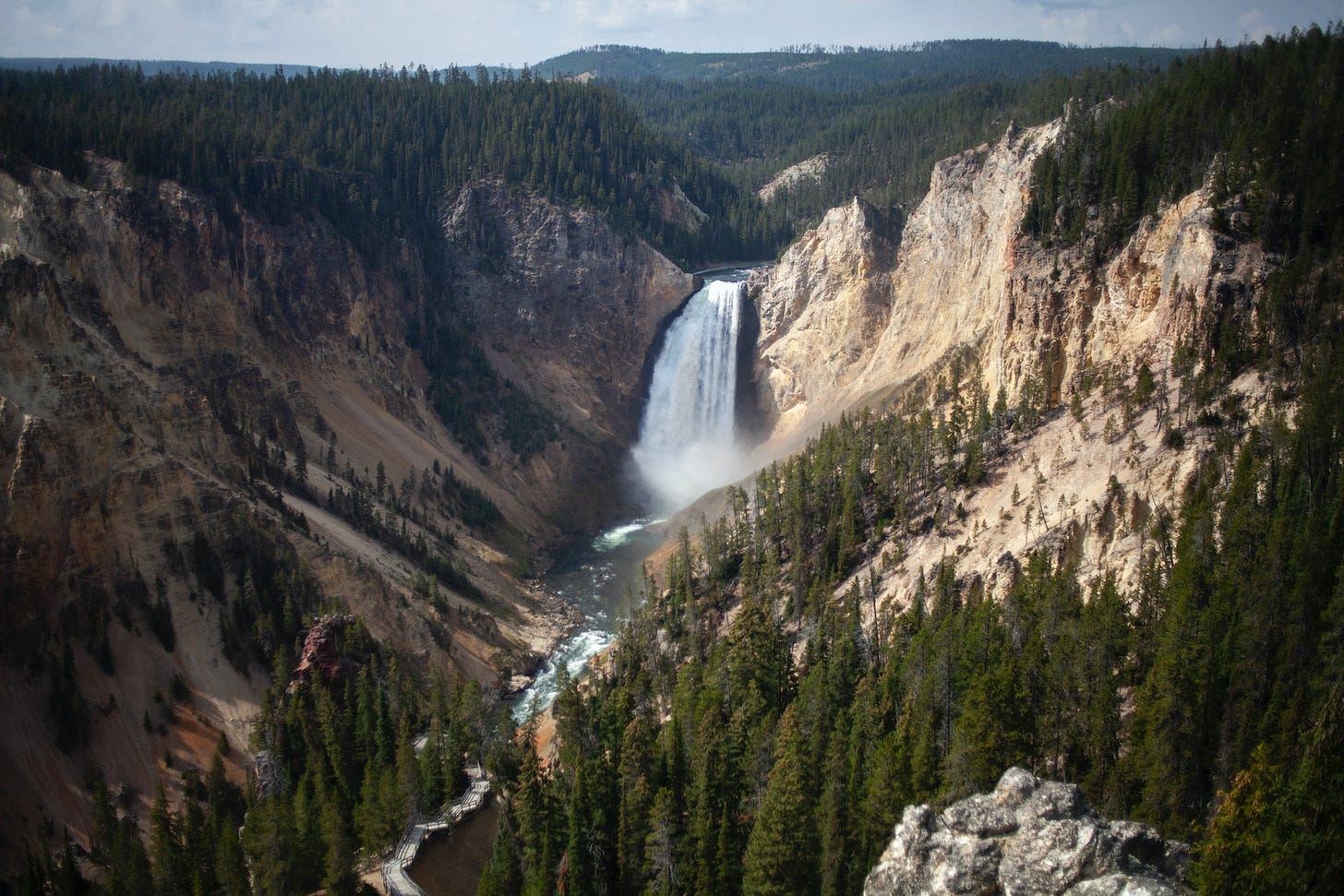What Makes A Successful Startup Ecosystem?
If it takes a village to raise a child, it takes an ecosystem to raise a founder.

9am - 11am, Tuesday 18th April 2023
I was having a chat with a friend and long time ally in the good fight recently about why we haven’t seen certain elements of the ecosystem develop in South Wales in quite the way we had hoped.
Ecosystems are complicated things.
In nature, they’re the systems that sustain life. The conditions in which interconnected elements interact with different parts of the environment and community.
Some of these things are fully automatic, some are influenced by external factors.
The best example in nature in recent years is the reintroduction of wolves to Yellowstone National Park.
Wolves and Beavers
When wolves were brought back to the ecosystem, beaver populations increased. How is this possible?
In the 1930s, the last wolf was hunted and killed in Yellowstone National Park.

This extermination was an intentional attempt to reduce the number of predators in the park, coordinated and funded by the U.S. federal government.
Natural ecosystems can appear chaotic, unpredictable and uncontrollable, but this isn’t necessarily the truth.
When the last wolf was taken from the ecosystem, there were consequences.
The departure of the wolf was good news for the elk population. With a significant predator taken out of the picture, they got lazy.
Rather than staying on the move, the elk found a comfy spot and ate up all the young willow saplings which then didn’t grow to provide food for the beaver colonies.
This also left elk susceptible to sudden ecological shocks, such as tough winters.
When the wolves were reintroduced there was an immediate incentive introduced to keep elk on the move, which also gave willow, aspen, and cottonwood trees a new lease of life.
Now, there are three times as many elk and nine times as many beaver colonies.
The introduction of a new predator had counterintuitive consequences, but this is the value of the whole ecosystem.
What Has Any Of This Got To Do With My Business?
I’m not suggesting we bring wolves back to the streets of Islington or Barnstaple, although metaphorically speaking this may already play out.
The important lesson is to recognise our role in our own ecosystem, what our fuel sources are, where our relationships create value, and how we can view everything as controllable or predictable.
Ecosystems have a big impact on the success of our businesses, so what do we need to do to help our beaver colonies and cottonwood trees to thrive?
What Do Our Ecosystems Do?
The thing I’m really curious about is whether or not we can predict how successful an ecosystem can be just by looking at its make up.
Do certain areas have a fixed ceiling because they don’t have enough tax advisors in the mix? Do investors come to a region because there is a thriving ecosystem whether they recognise it or not? Is your likelihood of sharing a corridor in halls at university with a future lawyer an unrecognised advantage later in life when it’s time to start a business? Does a successful ecosystem speak for itself?
A business relies on different support from its ecosystem at different stages of growth. Its founders may knowingly or unknowingly benefit from how mature and effective the local ecosystem is.
If you are in the cybersecurity sector then you’re likely going to head to an ecosystem that has a reputation for developing great cybersecurity businesses, like Cheltenham or Reading. If you’re in the film or TV sector you’re looking at Cardiff, Bristol, Manchester, or Leeds.
Being in the right ecosystem can make it easier to access the right talent, investment, advice, and - crucially - customers to thrive. It isn’t to say that being outside the ecosystem makes it impossible, but that you are losing out on natural advantages that can be taken for granted in an established ecosystem.
The ecosystem isn’t always open to everyone, and is very rarely totally visible. It isn’t one thing, but it can sometimes be encapsulated in a conference, a coworking space, an academic institution, Slack channel, or something less formal.

The pub that gets a reputation on a Thursday night for being the place to go to rub shoulders with interesting people. The group of five people that you commit to getting breakfast with every month with no fixed agenda. The impromptu email you get from someone you haven’t heard off in three years making an intro to someone interesting they met.
Ecosystems are networks of people, but it’s also the relationships and responsibilities they sense they have to each other.
It’s the rising tide that can lift all boats, and give increased opportunity to successfully set sail.
Mapping an Ecosystem
So why map an ecosystem? And what does that mean?
When we at TownSq open new spaces in new places, we strive to be hypersensitive to the existing ecosystem, its strengths, weaknesses, and current momentum.
To start that process, we do an ecosystem map. It’s an interactive workshop with a small group of stakeholders who have visibility over the whole community. Who are the funders? Who are the supporters? Who are the professional service providers? Who helps to bring people together?
We break it down into ten categories:
Established businesses
Entrepreneurs & freelancers
Business support organisations
Public sector
Investors & funders
Media & press
Community groups
Professional services
Educators, HE & FE
Networks & associations
Each of these groups contribute to the success of a healthy ecosystem, in different ways and styles.
In some parts of the UK we find there are no intellectual property experts, but plenty of public sector business support organisations. In others there might be plenty of investors and funders but no obvious, publicly accessible networks or events to make them more visible.
Mapping the ecosystem helps us to identify where we ought to do more, or less, and who we can provide resource and support to rather than trying to duplicate efforts and compete. It enables us to take more of a shoulder-to-shoulder approach rather than perpetuating futile and destructive internal competition.
Ecosystem Frameworks
At the Global Entrepreneurship Congress in 2022, Cecelia Wessinger and Andy Stoll shared 7 elements of successful entrepreneurship ecosystems, following research with the Kauffman Foundation.
These elements are:
Inclusive and shared leadership which drives the mission forward in a welcoming way.
A collaborative culture to put reductive competition aside.
A shared vision upon which all stakeholders get behind and echo.
Connected networks that are welcoming and inclusive.
Methods and metrics to measure performance and progress against the vision and goals.
Universal support, open to constructive challenge.
A focus on ensuring that this is sustainable work that outlasts the participation of a small group of leaders.
Not all ecosystems become ecosystems by following this playbook or by even recognising these elements, but successful ecosystems thrive when these are in place.
In their 2019 Entrepreneurial Ecosystem Building Playbook, the Kauffman Foundation identified that a thriving ecosystem includes these key qualities:
Entrepreneurs in the first place who start and grow new the businesses, and the organisations that support them
Talent pipelines to enable the companies to grow
Knowledge and resources from people, organisations, and institutions that specifically help entrepreneurs
The champions and conveners of entrepreneurs, stakeholders, and the ecosystem
Onramps (or access points) to the ecosystem that enable anyone to participate
Intersections and crossroads that create collision points and interaction of people, ideas, and resources
The stories and narrative that people perpetuate about their ecosystem and their role within it
Culture that is rich in social capital – built on trust and enabling collaboration, cooperation, reciprocity, and a focus on the common good – makes the ecosystem come alive by connecting all the elements together
A third framework to share comes from the Global Ecosystem Dynamics Initiative (GED). The GED recognises there are two things that we need to be fully aware of for an ecosystem to perform at its best: understanding truly what role we have to play in the game, and accepting that collaboration is the most important resource we have to play.
The indicators used by the GED are as follows:
Understanding the roles of key organisations in an economic ecosystem
Identifying what is the first-contact motivation
The direction of first-contact
How many attempts to start a collaboration
Whether the collaboration is formal or informal
The intensity of collaboration
Giving reasons for collaboration success and failure
What resources are allocated for collaboration
There are also six roles in the ecosystem identified in their work:
Communities
Promoters
Knowledge generators
Articulators and storytellers
Enablers
The binders, linkers, and connectors
All connected by a common purpose and creating value for entrepreneurs and innovators
Why I’m Excited We’re Doing This At UCL
The best example I could think of to explain to my friend as to why our ecosystem in South Wales isn’t thriving was looking at somewhere like UCL BaseKX, and the great work that Jerry Allen and the team have been doing there.
At UCL, you have a perfect ecosystem that creates the conditions for sustained success.
You have communities, you have ideas, you have promoters, you have connectors, you have investors, you have intention, you have vision, you have talent, you have sustainability, common purpose, all of these things and more.
The common purpose and commitment comes from the fact that unashamedly UCL benefits as a participant and driver of this ecosystem. Regional ecosystems can learn a lot from understanding how environments like UCL, MIT, and other closed ecosystems create meaningful success for all stakeholders.
If more people recognise their role as ecosystem enablers, we can help to make people more “ecosystem literate”. We can increase the pressure on all stakeholders to be building something for all participants.
One of the things that really resonated from the talk that Cecelia Wessinger and Andy Stoll gave was the call to action at the end. We need more people who identify as ecosystem builders. How many people have you ever heard say “I am an ecosystem builder”? If we want to make the word ecosystem feel less cringy, we need to use it in more positive ways on a more regular basis.
Are you an ecosystem builder? Can you identify your local ecosystem?
Join us this Tuesday morning at UCL BaseKX in central London to talk more about ecosystems!
9am - 11am, Tuesday 18th April 2023
Read next…
Failure isn’t an event, it’s a decision
Act Like You’ll Be Around Forever
If you intend to create a business that lasts, start acting like it
Think about simple everyday acts like eating last to be a better leader





Great thoughts and insights Gareth! I'm glad to hear that Cecilia and my conversation at GEC was helpful! #KeepBuilding
PS -- Perhaps this video might also be helpful https://www.youtube.com/watch?v=a7oQJteZn48